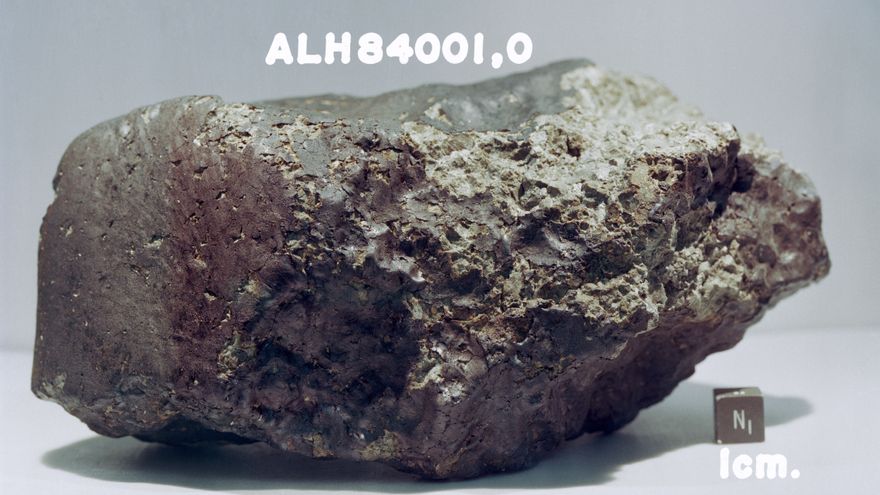The Martian meteorite discovered in Antarctica in 1984 called ALH 84001 contains organic molecules, but it does not show life on Mars more than 3000 million years ago. The scientific debate continues.
A new investigation sparked a scientific controversy that arose in 1984, when a meteorite of Martian origin, called ALH 84001, was discovered in a remote corner of Antarctica.
ALH 84001 was formed on Mars 4.5 billion years ago and after roaming in outer space reached Earth about 13,000 years ago. Analysis of this meteorite prompted NASA to announce in 1996 that a possible primitive form of life could have existed on Mars over 3 billion years ago.
Two years later, another investigation from the University of California indicated that previous conclusions obtained from the analysis of the meteorite were contaminated with the ice surrounding the Martian rock.
In another 2020 studycarried out by scientists from the Japan Aerospace Exploration Agency (JAXA) and the Tokyo Institute of Technology (ELSI), have identified nitrogen-containing organic compounds within the meteorite, supporting the idea that there may have been life on Mars in the distant past.
chimical interaction
The new research, led by the Carnegie Institution for Science and published in the journal Science, concludes that the organic molecules found in a Martian meteorite are not signs of life, but formed in chemical reactions between water and rock on the Red Planet about 4 billion years ago.
Organic molecules generally include any compound containing carbon, and can also contain oxygen, nitrogen, sulfur and other elements. The researchers note that these organic compounds are often associated with life, but can also arise due to abiotic or non-biological activity.
They add that chemical reactions that occurred between water and rock on the Red Planet produced organic matter from reduced carbon dioxide: in fact, the abiotic structure of organic molecules was part of Martian geochemistry for most of the Red Planet’s history.
They also explained that Mars rovers have found complex organic molecules in ancient rocks exposed on the planet’s surface, as well as methane in the modern atmosphere.
However, it has never been clear which processes produced these organic compounds, with proposals to include both biotic and abiotic sources. The same debate was repeated with the Martian meteorite in Antarctica.
Just like on Earth
The new research found that organic compounds in a Martian meteorite from Antarctica were bound to minerals similar to serpentine, which is frequent in humid environments.
These results indicate that the organic chemicals detected in ALH 84001 may have been formed due to water-rock interactions, similar to those known to occur on Earth.
One process, called serpentine, occurs when igneous rocks rich in iron or magnesium chemically react with circulating water, changing their mineral nature and producing hydrogen.
The other reaction, called carbonation, involves the reaction of rocks with slightly acidic water containing dissolved carbon dioxide to form carbonate minerals.
The researchers concluded that the organic compounds in ALH 84001 were formed when igneous rocks interacted with saline fluids early in Mars’ history.
bottom signal
“These types of non-biological geological interactions are responsible for the range of organic carbon compounds from which life may have evolved and are a background signal to consider when looking for evidence of past life on Mars,” he explains. The director of this investigation, Andrew Steele, in a Release.
Moreover, if these reactions occurred on ancient Mars, they must have occurred on ancient Earth as well, and could also explain the results we saw on Saturn’s moon Enceladus. All that is required for this type of organic synthesis is for a brine containing dissolved carbon dioxide to seep through the igneous rocks,” Steele adds.
He concludes: “The search for life on Mars is not just an attempt to answer the question are we alone? It is also about early Earth environments and addresses the question of where did we come from?”
The massive debate may continue over whether or not ALH 84001 includes fossils of microbes from Mars, although new research suggests that abiotic factors could help explain these apparent fossils.
reference
Organic synthesis related to serpentine and carbonation in early Mars. Steele et al. Science, January 13, 2022. Volume 375, Issue 6577, pp. 172 – 177. DOI: 10.1126/science.abg7905

“Beer enthusiast. Subtly charming alcohol junkie. Wannabe internet buff. Typical pop culture lover.”







More Stories
The only human structure that can be seen from space is in Spain
Ubisoft announced that the free trial of Assassin's Creed Mirage will be available until the end of the month
Do you have reminders saved in Google Keep? They could disappear soon